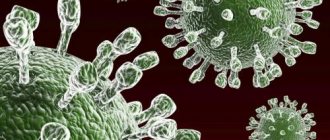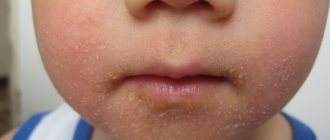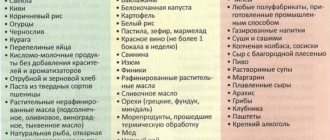When loose stools are normal
Parents often worry about loose stools in their newborn. But it is important to understand that breastfeeding is normal physiology. There is no need to worry if there are no other signs of a condition disorder.
There are situations when loose stools in a breastfed baby indicate the development of diseases, but this condition is always accompanied by additional external signs .
It’s very easy to explain why a newborn’s stool is loose when breastfeeding. When eating only high-calorie, soft and fatty foods, feces cannot harden. A mushy consistency is normal until complementary feeding is introduced in infants.
The shade ranges from yellow to light brown. At times, the color may change, but if there is no mucus or blood in the stool, and if there is no pain in the tummy, then everything is fine.
Stool color varies from light yellow to dark brown
If a newborn has loose yellow stools, but the baby has good dynamics in weight gain, has no problems sleeping and does not show alarming signs, then his parents should not worry in vain. The baby eats liquid, easily digestible food and therefore it is logical that the feces are liquid. This should not be associated with diarrhea.
A breastfed baby can normally defecate 7 to 10 times a day in the first month of life. Bowel movements occur after feedings. From 1 to 6 months, the baby goes to the toilet 2-5 times every day, and after six months - 1 or 2 times, and maybe less often.
With frequent pathological bowel movements, the baby quickly loses the fluid it needs. At this time, the baby needs to be given a lot of water to prevent dehydration and disturbances in the functioning of organs and systems.
If a newborn has loose stools, behaves restlessly, cries often and heavily, or has a bloated tummy, you should urgently call a doctor.
Normally, a baby has loose yellow stool, but it can be greenish, light yellow or brownish. The color depends on the nutrition of the nursing woman. When dairy products are included in her diet, the feces are yellow, and plant products are greenish.
The norm is the absence of mucus and blood in the stool .
Sometimes curdled lumps may appear, and the smell is like sour milk. If the baby is feeling well and has a stable weight gain, there is nothing to worry about. This is a natural response to easily digestible food.
Normal stool of a newborn with artificial feeding.
A newborn on artificial feeding eats differently than a baby receiving mother's milk. This means that the stool of an artificial baby and the stool of an infant will be different, because the composition of human milk and formula, no matter how hard the baby food manufacturers try, is still not identical. Therefore, let's decide on the criteria by which we will determine whether everything is fine with a newborn's stool: color, consistency, smell and frequency.
Color.
- Normally, the color of a formula-fed newborn's stool is naturally yellow or dark orange, and it depends on the formula you choose.
- If you see white inclusions in the stool, it’s not scary: the newborn’s digestive system is maturing and learning to cope with food; soon it will fully digest and assimilate the entire mixture.
- However, if the point is not in the physiological characteristics of the baby, but in the fact that you are simply overfeeding the baby (after all, he cannot tell you when he has “enough”), in the stool you will observe curdled undigested lumps, and the consistency of the stool itself will become thinner: this means that you need to review the portions in consultation with your pediatrician.
- When the stool is bright yellow or orange, you should definitely inform your doctor about this: this color indicates problems with the functioning of the liver.
- And green feces in babies older than a week can be a sign of unpleasant diseases such as dysbiosis, staphylococcal enterocolitis, rotavirus infection or a congenital inability to digest lactose (newborn feces - meconium - are greenish in nature, but this is normal only in the first days after birth).
- A danger signal is also the color of the stool being too dark, especially streaks or inclusions of blood in it. Blood in the stool may appear due to the presence of microcracks in the anus (a common occurrence after constipation, when dry and dense stool scratches the rectum), but the reason may be different, so consulting a doctor is also necessary.
Consistency.
The stool of bottle-fed babies is always denser than that of infants, so it is important for the mother to ensure that it is not too hard - it will be very uncomfortable for the baby, and in the long term this can lead to constipation. The normal consistency of newborn stool is mushy; stool becomes more formed only after the introduction of complementary foods. Liquid stool in artificial babies is also a sign of problems; usually, in addition to thin consistency, there are also changes in the frequency of bowel movements, color and smell - all these are signs of an intestinal infection, and a little later we will talk about this in more detail. In addition, this may be a sign of an individual negative reaction to the mixture. In this case, you will have to choose another one, after consulting in detail with your doctor.
Smell.
A newborn who is bottle-fed has a more pronounced stool odor than a baby who is fed naturally, whose stool normally has a faint odor before the introduction of complementary foods. A putrid smell in combination with a liquid consistency and the appearance of foam can be a danger signal - such stool must be removed by a doctor, it can be a sign of a staphylococcal infection in the intestines.
Frequency.
Babies who are bottle-fed empty their tummy up to 6 times in the first days, but gradually the functioning of their body becomes more orderly and predictable, and just a few weeks after birth, babies can already have stool only once a day, while For a breastfed baby, it can be given several times a day (usually after each feeding). This is due to the fact that, unlike mother’s milk, baby formula takes longer and is more difficult to digest – the baby just needs more time.
Short-term causes of bowel dysfunction - complementary feeding and teething
It happens that in addition to teething, painful sensations in the gums, flow of saliva and irritability, other symptoms are added. One of them is a violation of the consistency of stool.
The baby is teething, crying and experiencing discomfort
A very common reason when a baby has loose stools is teething under the influence of a bacterial infection.
It enters the child’s body due to the fact that he begins to intensively drag his hands and any available objects into his mouth in order to scratch his inflamed gums.
Saliva protection in infants is poorly developed, so the infection manifests itself in the intestines, causing diarrhea.
To reduce the negative impact of teething on the body, you need to:
- periodically wipe saliva from your chin;
- pay more attention to hygiene - change your blouse more often so that saliva does not accumulate on it;
- You should wash your hands frequently or dry your hands with wet wipes.
To avoid diarrhea during complementary feeding, you must adhere to the following rules:
- monitor the quality of food, introducing complementary foods very carefully;
- when restructuring the body, you should be careful about the choice of dishes;
- Proper nutrition will reduce the risk of dysbiosis.
Often the causes of loose stools in infants are the adaptation of the digestive system to new foods.
At the same time, the intestinal microflora is populated with beneficial bacteria. But a sufficient amount of enzymes is not yet produced, and the anatomical location of the gastrointestinal tract helps speed up the digestion of food.
Causes of diarrhea in newborns
Foamy stool with copious mucus, admixtures of blood and pus indicates an acute intestinal infection. In this case, the infection is accompanied by frequent regurgitation and fever. In this case, consult a doctor immediately!
As television pediatrician Komarovsky says, intestinal infections in children under five years of age occur due to rotavirus. This disease begins as an acute respiratory infection. The baby has a fever, a red throat and a runny nose. At the same time, the child begins to vomit and have diarrhea. Children under one year of age are difficult to tolerate such diseases, so it is important to consult an expert!
Among the intestinal infections that lead to diarrhea are dysentery bacillus, staphylococcus, enterovirus and others.
As Komarovsky testifies, breastfed children are at much less risk of getting such an infection than when fed with artificial formula!
Overfeeding causes stomach upset, which leads to diarrhea in infants. Don't forget about proper nutrition while breastfeeding. Feed your baby on demand, not on a schedule.
Teething often causes diarrhea. At the same time, the baby’s gums turn red and saliva is released profusely. Teething is accompanied by frequent crying and sometimes fever. Contact your pediatrician to select the appropriate dental gels. They will relieve pain and alleviate the condition of the baby.
The cause of prolonged diarrhea can be dysbacteriosis, which requires doctor's intervention. The disease is not accompanied by high fever and is rare. There is weight loss and sometimes a rash appears.
What are the differences between norms and violations?
Diarrhea can be distinguished from a normal physiological state by the following characteristics:
- increase in the number of bowel movements per day;
- stool liquefaction and wateriness;
- sudden release of feces;
- pronounced sour odor;
- green tint;
- the presence of blood streaks, foam and mucus.
At the same time, it is recommended to monitor the child’s general well-being.
Additional signs
- colic and gas;
- sleep disturbance during the daytime and at night;
- poor appetite;
- causeless whims;
- rise in temperature.
But often the color and consistency of feces in a normal state will depend on the individual characteristics of the baby’s body.
What parents can do, rules for correcting nutrition
Tips for preventing diarrhea in infants:
1 Don't give up breastfeeding. Some young mothers stop breastfeeding due to their inexperience. This is completely wrong. Breast milk contains special substances that help the unformed body overcome intestinal infections, as well as resist the influence of allergens. Microbacteria in milk will allow the gastrointestinal tract to work correctly. We tell you how to resume lactation if milk has disappeared in a separate article. During diarrhea, the body loses a huge amount of fluid, and milk helps replenish it.
2 Changing the mother's diet. The diet of a nursing woman significantly affects the baby's stool. Greens, fruits, vegetables and juices especially change the consistency of stool. It is recommended that the mother keep a diary to record the time of introduction of new food and the reaction to it . You need to include foods in the menu one at a time, in small quantities, monitoring the child’s well-being.
3 Monitor how the baby’s body reacts . If it gets worse, you need to urgently call a doctor.
4 Make sure your baby drinks the whole breast. It is known that mother's breast milk is divided into fore (watery) and hind (more fatty, high-calorie). If the baby often sucks only foremilk, then the frequency of trips to the toilet will increase. Feed with one breast until you feel completely empty, and only then invite him to start on the second. If the child does not want to latch on and is freaking out, carefully study the possible sources of problems from our article. In the event that a mother’s breasts hurt during feeding, it is imperative to get information about why this might be happening. Such symptoms do not bode well.
5 Don't be nervous. Parents often become nervous even at the slightest deviation. If the baby remains calm and in a good mood against the background of loose stools, nothing bad happens.
Bowel frequency during breastfeeding
The color, consistency and frequency of stool in an infant during breastfeeding may change. These components depend on the time of day, maternal nutrition and the amount of fluid consumed, and the individual characteristics of the child’s body. Also, the number of bowel movements may increase/decrease as the emotional and/or physical condition of the nursing mother worsens.
Every mother thinks about how many times a breastfed newborn should have stool. The following are normal indicators at different periods of a baby’s life after birth:
- First days. The life activity of the infant is characterized by bowel movements of meconium (original stool). The frequency of bowel movements can reach 6 times or more, which depends on the filling of the intestines and its functionality.
- For 2 – 5 days. During life, bowel movements may be absent or meconium may continue to be passed. This substance is produced in the children's intestines in the womb, therefore, due to the incomplete release of meconium from the intestinal cavity, regular feces cannot appear. At this stage of life, the frequency of stool in a newborn, as a rule, does not exceed three times a day.
- For 2 weeks the baby may defecate irregularly, which is not considered a deviation for this period. During the first 3 weeks. lactation is established, mother's milk has a variable composition. This may affect the frequency and consistency of a newly born baby's stool. From 2 – 3 weeks. the child may begin to suffer from increased gas formation and colic.
- Time period from 3 to 6 weeks. after birth, it is characterized by frequent bowel movements (up to 10 times a day), since breast milk has a laxative effect. Rare stool in a breastfed baby (less than 4 times per day) indicates problems with lactation.
- After 6 weeks The frequency of stools may sharply decrease to 2 - 4 times per week. Pediatricians call this period an enzyme crisis. Thus, the baby's digestive system reacts to renewed breast milk. At this stage, the baby develops new enzymatic compounds, which can last for several weeks. In this case, a change in the baby’s behavior may occur.
- The functionality of the children's digestive tract enters an individual regime when the child reaches two months of age. It is possible to reduce the frequency of bowel movements to 1 - 2 times per day. However, frequent bowel movements (up to six times/day) are also normal.
- After 6 months It is allowed to introduce complementary foods, due to the sufficient production of enzymes in the baby’s body. At the same time, the consistency of stool becomes denser, the frequency of bowel movements is reduced, and the smell becomes pungent.
We recommend reading: Weight gain in breastfed newborns by month
With frequent bowel movements, starting from 2 weeks. life, it is recommended to weigh the baby regularly. However, it should be borne in mind that a decrease in body weight during the first week after birth is considered normal. Weight gain (about 150 g/day) with high stool frequency is also not a pathology.
When do you need a doctor?
If watery stool occurs frequently in an infant, it should be a reason to consult a doctor.
There are a number of additional signs of diarrhea that indicate deviations from the norm:
It is worth paying close attention to the presence of accompanying symptoms.
- Anxiety in behavior . When the baby knocks his legs, does not latch on the breast, sleeps poorly, and it is clear that his stomach is bothering him - call the doctor.
- Dangerous signs are when loose stools in an infant are accompanied by vomiting, severe fever and weight loss. All this can be life-threatening and you should call a doctor immediately.
- Symptoms of dehydration - they develop just with diarrhea - are general weakness and lethargy of the child, weak cry, lack of tears, tightness of the skin, sunken fontanel, dark urine with a pungent odor, a diaper that remains dry for a long time and a high temperature.
- A clear putrid smell of excrement - this may indicate the development of pathogenic intestinal microflora.
- Dysbacteriosis – develops when the composition of the intestinal microflora is disrupted. To confirm the diagnosis, get tested.
- Lactase deficiency. This diagnosis is also made only on the basis of tests. In the first weeks of a child’s life, the lactase enzyme is not produced in his body - namely, it breaks down carbohydrates from breast milk. Therefore, diarrhea develops, the baby becomes restless and does not gain weight well. Diagnosis of lactase deficiency requires submitting stool to a laboratory.
- Intestinal infections. They are difficult in different ways. In this state, very loose stools, like water, in the infant are accompanied by fever, vomiting, blood and mucus in the stool. After analysis, an increase in the concentration of fats and leukocytes is diagnosed.
In addition to the listed disorders, diarrhea may indicate an allergy to certain foods consumed by the mother or to the food itself. To normalize the condition, you will need to eliminate the allergen product from your diet.
If a child has problems with the gastrointestinal tract, he will definitely show it through his behavior. When the baby feels good, is cheerful and plays, then most likely he does not have any disorders.
Color and smell of stool in a child with breastfeeding
A baby's stool on the first day after birth is called meconium, which has a dark greenish color. Original feces are odorless and have a viscous, sticky consistency. Meconium consists of the remains of amniotic fluid, prenatal hair, digestive secretions, and epithelial intestinal tissue. After two or three days, children's feces undergo changes.
The ideal baby feces are:
- liquid or mushy consistency;
- with a small amount of mucus;
- yellowish, brownish-reddish or green color;
- with an odor that resembles slightly sour milk;
- The presence of small whitish or yellow lumps is acceptable.
When breastfed, the baby usually defecates profusely, about 3 to 4 times a day, which can happen immediately after eating. Some deviations from the norm are possible (defecation 1 time per week or up to 10 - 12 times per day). These phenomena are not considered a pathology, provided the baby has a good appetite and is feeling well . A two-month-old breastfed baby's stool can drop to 5-7 times a day. At the same time, the feces remain soft and puree-like.
The reasons for the appearance of foam in the stool of a baby are safe and those that need to be paid close attention to, as they can cause serious complications. If the baby’s development is normal, there is no capriciousness or lethargy, then the reason for the appearance of foam in the stool lies in the mother’s nutrition. This phenomenon can occur when a nursing mother introduces a new product to her diet. In this case, the color of the stool becomes greenish-yellow, and mucus may be present.
After consuming a product unfamiliar to a child’s body, it is necessary to monitor the baby. If the consistency and color of the stool changes, as well as the baby’s behavior over 3–4 days, you should stop consuming new food. Also, foamy stool in a newborn can occur during hasty feeding, as a result of which the stool becomes greenish in color.
Another “safe” reason for the appearance of foam in the stool, which is easy to eliminate, lies in the baby’s failure to receive “hind” breast milk, which has a thick consistency and contains a large amount of fats and enzymatic compounds that break down lactose. Foremilk is a source of proteins and water-soluble minerals and penetrates into the baby’s stomach immediately after consumption. The baby needs to be fed two types of breast milk, since the “back” helps to absorb the “front”. When consuming only the second type, children's stool may become watery, foamy, and dark.
In addition, foamy stools in infants can occur due to insufficient nutrition, which is possible with infrequent feeding and/or small portions. Malnutrition can provoke the development of colic in the baby, increased gas formation and foamy stools. Relief occurs after the release of intestinal gases. In this case, it is necessary to put the baby to the breast more often, and the mother should stop eating sweets and cow's milk.
However, there are also quite serious reasons for the appearance of foam in children’s stool, which requires consultation with a pediatrician.
Lactase deficiency
Lactase deficiency can manifest itself along with the appearance of a sharp sour smell of stool and an increase in bowel movements. Lactase is an enzymatic substance that helps break down lactose (milk sugar present in breast milk). When there is a shortage of lactose, undigested lactose penetrates the children's intestines and provokes the formation of foam.
Symptoms of the development of lactase deficiency include:
- feeling of nausea;
- colic and bloating;
- frequent regurgitation;
- the child’s refusal of the mother’s breast, accompanied by crying;
- rumbling and painful sensations in the tummy.
In this case, the stool becomes not only foamy, but also contains mucus and acquires a yellowish-green tint. This disease is usually characteristic of weak, premature babies. Congenital lactase deficiency is extremely rare, which is accompanied by a rapid decrease in the child’s body weight and requires emergency treatment.
When treating diseases of infectious origin with the help of antibiotics, the production of lactase in infants decreases, incompletely digested food and a large amount of watery mucus appear in the stool.
It is impossible to independently diagnose this cause of foamy stools. Only a pediatrician can make a diagnosis and prescribe appropriate therapy, who must first refer the baby for certain tests:
- feces (if there is pathology, a high level of carbohydrates and increased acidity will be found in the stool);
- exhaled air (lactase deficiency in the body can be determined by the presence of hydrogen and gas during exhalation).
We recommend reading: Symptoms and treatment of ARVI in infants
However, the latest study is not suitable for children under 3 months.
Disease of infectious origin in the intestines of infants
If there is an infection in the child’s body, the stool becomes foamy, acquires a bright greenish color, and a fetid, putrid odor. This occurs due to the proliferation of pathogenic intestinal microflora. Pathogenic microorganisms can enter the baby’s body through unwashed hands, an unsterile pacifier, unboiled water, and diapers that have not undergone sufficient treatment.
Intestinal infection is accompanied by:
- development of intense vomiting;
- a rapid increase in the child’s body temperature;
- complete refusal to eat;
- loud, high-pitched screaming/crying for a long time;
- twisting your legs, pulling them towards your stomach.
If such symptoms appear, you must immediately call for medical help. Getting rid of gastrointestinal tract infections in infants occurs only under medical supervision (in a hospital setting).
This disease is dangerous as it provokes the development of severe profuse vomiting, which threatens dehydration. Therapy in a hospital consists of introducing therapeutic agents into the child’s body with the addition of glucose using a dropper. This will help restore fluid balance, reduce/eliminate fever and symptoms of fever. The doctor may also prescribe antiviral, antiemetic and antipyretic medications.
Dysbacteriosis
This problem occurs in 97 percent of babies. Premature babies with weakened immune systems are especially susceptible to changes in the intestinal microflora. Dysbacteriosis may be a consequence of late breastfeeding or the forced use of antibiotic drugs by the mother while breastfeeding.
In order to detect this unpleasant phenomenon in a child, you should pay attention to the presence of the following clinical signs:
- the occurrence of thrush;
- gagging;
- loss of appetite;
- rumbling and bloating;
- drying of the skin;
- development of allergic reactions;
- increased salivation, independent of teething;
- formation of an unpleasant odor from the children's oral cavity;
- the appearance of foam in the stool mixed with mucus/blood.
To diagnose this condition, the doctor must refer the baby for a coprogram, which determines the presence/absence of an inflammatory process in the gastrointestinal tract, as well as the degree of digestion of food by the intestines.
The process of restoring beneficial microflora is lengthy. To do this, the pediatrician prescribes the use of so-called bacteriophages, which fight pathogens. Also, for dysbacteriosis, the use of sorbents, which are needed to remove toxic compounds from the child’s body, and enzymes (to restore the functionality of the gastrointestinal tract), is indicated. After a course of treatment, the pediatrician should prescribe medications containing lacto- and bifidobacteria, which are necessary to populate the intestines with beneficial microorganisms.
An excellent preventive measure is feeding the baby with mother's milk, which contains important antibodies that take an active part in protecting the child's body from the penetration of viruses. Breast milk contains bifidus factor. This compound participates in the formation of normal microflora and prevents the development of pathogenic bacteria in the child’s digestive tract. Therefore, during the lactation period, it is very important for a woman to adhere to a well-designed dietary menu.
conclusions
Loose stool in an infant is a physiologically normal condition . It is much worse when the baby suffers from constipation, he becomes bloated and develops colic. The color, consistency and smell of baby stool make it possible to timely diagnose gastrointestinal dysfunction. If there are no additional pathological manifestations, this is not an indicator of violations.
You can find out more information about what feces are considered normal and when they are not from the video:










